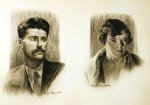
Now for the matter of scoring: When one starts, the finding of the first few pieces would naturally seem to be the most difficult. The perimeter of a small assembled group is small and the choice of pieces which might be expected to fit is a maximum. As the assembly progresses one might expect the ratio of correct tries to false tries to tend to increase. Actually the reverse may tend to obtain. When the puzzle is first started, the first pieces which are seen to match may be a large part of a small group of easily recognized pieces even though they are not segregated. Toward the end the few remaining pieces may be of nearly uniform color or texture and most difficult to match. As a result the ratio for any one puzzle and puzzler tends to be a constant with interesting fluctuations.
I have frequently noticed that when continuing work on a puzzle on a subsequent day that I may suddenly notice a piece which I had been seeking on the previous day. From this it appears that memories of the identifying characteristics of a particular piece may be imprinted into the mid- or long-term memory. This seems to be most pronounced in cases where considerable time had been spent in the original fruitless hunt. In other words, it pays to study. It also appears that a rest may give the subconscious memories a chance to soak in. I note from the literature that considerable effort has been made at understanding the learning of verbal material in the form of nonsense words and so it is interesting to note that this also applies in the visual realm.
One of the reasons for the study of verbal learning being so far advanced (as against the study of visual learning) is the convenience of examining the results. Questions which may elicit yes or no answers are comparatively easy to contrive and examination papers are so easy to score that the process can be computerized. Tests for visual acuity and memory are harder to devise and bulky to test. In part this may account for the predominance of regard for verbal learning in contrast to visual skills.
This method of scoring puts the jigsaw puzzle working business into a class with golf or nine or ten pin bowling. In these games the players don't directly affect each other's play, neglecting psychological factors. But these games are almost unthinkable without some kind of scoring. In the case of golf there is a 'designed' game which the course is built to present as an obstacle. Perhaps puzzles could be pre-scored so that a customer might buy a puzzle with some clear understanding of the relative difficulty. I am sure that I have considerable satisfaction in my scores in 'puzzling.'


